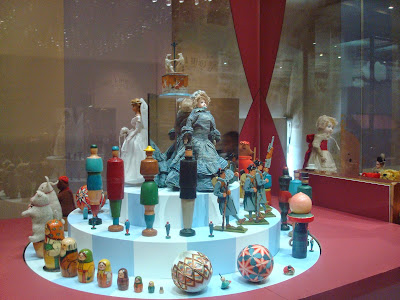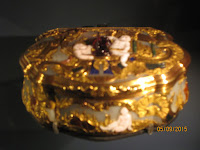A return visit to the Louvre seemed much warranted.
And if one of the my travel companions had his way, we probably would have spent the rest of our time in Paris at the Louvre.
There's something very arty about this bronze facial fragment. I had thought it to be of Hadrian, but it is of another emperor, Marcus Aurelius.
Yet another animal statue.
Left: Aphrodite Untying Her Sandal. This graceful statue likely originated from Syria, where the goddess, or rather a version combined with other goddesses Isis, Hathor, and Astarte, had a large following.
Right: Cameo of Augustus. The setting and the base are 18th century. The cameo is thought to bear a good likeness to the emperor. It is well known that Augustus had a boy-ish face.
Often, one forgets to admire the palatial rooms that house these wonderful collections.
And continuing on where we left off... the Egyptian collection.
So shiny. So very very shiny.
Stele of Lady Taperet (10th/11th century BC)
The sun god Ra is depicted as shooting flowers at the worshiper Lady Taperet. (How cool would that be if the sun really shot flowers every now and then?) The papyrus (left) and lily (right) plants framing the stele represent lower and upper Egypt, respectively.
It's amazing that the colours have remained so vibrant and the wood material un-decomposed.
The God Amun Protecting Tutankhamun (14th century BC)
The statue was deliberately vandalized in an effort to erase the existence of Tutankhamun by one of his successors.
The head of the boy king was removed and his names on the statue struck out. Fortunately, the vandals missed one, allowing for identification.
Akhenaten (14th century BC)
Perhaps my favourite photo from the Louvre. The angle of the light produced a shadow that made the statue look whole once again. If the curators didn't plan this on purpose, then it is just too freaky.
The Seated Scribe (24th-27th century BC)
The identity of the scribe remains a mystery. On top of the statue's unbelievable realism, the most interesting detail is the eyes. Instead of simple onyx discs, pieces of polished rock crystal lenses were used in conjunction with a coloured material to "paint" the irises underneath the lenses. In effect, creating a far more realistic (but kind of spooky) eye. (Crazy, I know.)
Bowl of General Djehuty (16th-11th century BC)
The bowl was a gift from Tuthmosis III. The flat bottom of the bowl, with fish and papyri motifs, is rare for that period. The general's wiliness in battle has been preserved in the story "The Taking of Joppa".
Afterwards, we passed through a section of the nearby Decorative Arts collections.
Tea Service of Marie Antoinette
The teapot and cups are all marked with her monogram.
A selection of spectacular trinket/snuff boxes.
My favourite of the lot.
While I really enjoyed looking at these fabulous baubles, it's not hard to figure out why the Revolution happened. One of these trinkets probably could have fed hundreds of families for a month, at least.
Scientific Instruments
Yes, I am a nerd, and darn proud to be one.

The relatively new Islamic Arts section was much heralded.
While the new space was certainly unique and modern, I found the collection small and somewhat lackluster. Maybe it was museum fatigue kicking in, but there wasn't too many pieces that truly impressed.
Some of the pieces I liked.
Lunch: baguette bought from the morning market












































































